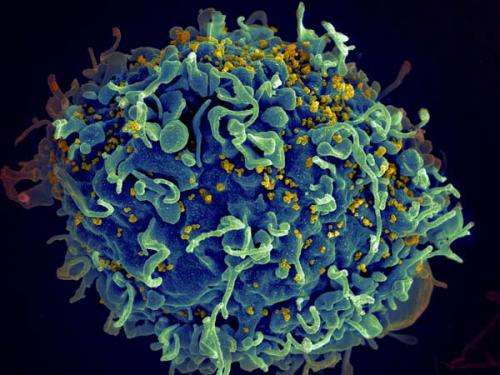HIV, the AIDS virus (yellow), infecting a human immune cell. Credit: Seth Pincus, Elizabeth Fischer and Austin Athman, National Institute of Allergy and Infectious Diseases, National Institutes of Health.
HIV particles are effectively trapped by the cervicovaginal mucus from women who harbor a particular vaginal bacteria species, Lactobacillus crispatus. The findings, published this week in mBio, an online open-access journal of the American Society for Microbiology, could lead to new ways to reduce or block vaginal transmission of HIV and other sexually transmitted infections (STIs).
"Mucosal surfaces, such as the lung, gastrointestinal tract, or female reproductive tract, are where most infections take place," says Sam Lai, assistant professor of pharmacy and engineering at University of North Carolina at Chapel Hill and senior author on the study. "Our bodies secrete over six liters of mucus everyday as a first line of defense."
Cervicovaginal mucus (CVM) can act as a barrier to prevent pathogens from reaching the underlying vaginal wall cells, but the barrier properties vary greatly from woman to woman and even at different times in the same woman. Lai and his collaborators wanted to know what accounts for those differences.
They collected fresh CVM samples from 31 women of reproductive age, measured various properties of the mucus and used high-resolution, time-lapse microscopy to test whether fluorescent HIV pseudovirus particles became trapped in the mucus or diffused freely.
The researchers observed two distinct populations of CVM samples, one that was very good at trapping HIV and one that was not. Trapping of HIV did not correlate to the mucus' pH, total lactic acid, or Nugent score, a rough measure of vaginal 'health' that reflects how many Lactobacillus bacteria are present compared to other microbes.
One difference between the two groups, higher levels of D-lactic acid in the group that trapped HIV, stood out to the researchers because humans cannot make D-lactic acid. The team suspected that different bacteria living within the mucus layer were responsible for differences in D-lactic acid. When they sequenced ribosomal genes to identify the bacteria within each sample, the researchers found that the samples fell again into two groups.
L. crispatus bacteria dominated the CVM that trapped HIV. In contrast, CVM that failed to trap HIV either possessed a different Lactobacillus species, L. iners, or had multiple bacterial species present including Gardnerella vaginalis—both conditions that are frequently associated with bacterial vaginosis.
"I was really surprised by how slight differences between Lactobacillus species make a very substantial difference in the barrier properties of mucus," says Lai. In the clinical setting, there is a clear link between bacterial vaginosis and having a higher risk of acquiring and transmitting STI's. Historically, Lai explains, gynecologists considered vaginal microflora to be healthy if it was dominated by any Lactobacillus species. "But our work shows that from a mucus barrier perspective, that is not a good enough distinction," says Lai.
Healthcare workers should be aware that women who harbor L. iners probably have a substantially higher risk of acquiring STIs. And conversely, a L. crispatus dominant microflora may be more protective against HIV and STIs than previously appreciated.
The group also showed that L. crispatus caused CVM to be more 'sticky' against HIV particles—rather than making a tighter mucus mesh. The barrier function was not unique to HIV particles and would likely trap other enveloped viruses as well.
Lai notes that CVM can be thought of as a "biological condom" which could potentially be reinforced by altering a woman's vaginal microbiota. "If we could find a way to tilt the battle in favor of L. crispatus in women, then we would be increasing the barrier properties of their CVM, and improve protection against STIs," he says.
Richard Cone, a biophysicist at Johns Hopkins University in Baltimore and another author on the study, is working on solutions that might deliver a sustained release of lactic acid to the vagina, which would encourage L. crispatus to thrive.
More information: The full study can be found online at mbio.asm.org/content/6/5/e01084-15
Journal information: mBio
Provided by American Society for Microbiology





















